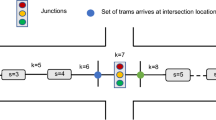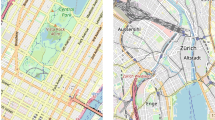Abstract
The modern tram has been recognized as a popular and efficient mode of public transit, and the signal priority for trams, particularly coordination on arterial streets, is a crucial and feasible strategy for improving the operation efficiency and level of service of trams. Different from the traditional “green wave” method, the fluctuations in dwell time at stops should be considered, and sacrifices to the automobile right-of-way must be controlled. Accordingly, a Support Vector Machine (SVM) model was proposed to predict the dwell time of trams at stops, which determines tram arrival times at the stop line. A two- sequential programming model to determine signal timings, including offsets and reallocations of green time, was then established. The upper level programming aims to minimize the stop frequency of a tram at the coordination region, and then, the optimal solution becomes the new restriction of the lower programming, whose objective is to minimize the overall delay of automobiles. This strategy was evaluated using the microscopic simulation software VISSIM using Tongjiang Road in Changzhou as the study region. The findings demonstrate that this strategy can significantly reduce more tram travel delays and stop rates on arteries than the conventional Transit Signal Priority (CTSP), and it definitively outperforms and the Static Two-direction Green Wave (STGW) method in decreasing these indicators of automobiles driving along arteries. Moreover, the satisfactory decreases in delay and average queue length at each intersection reflect a remarkable reduction or even elimination of negative effects from tram signal priority (tram SP). Finally, the stability of the proposed strategy in promoting both tram and automobile travel efficiency was proven by traffic volume sensitivity tests. The results and findings are meaningful for traffic managers to enhance the operation efficiency and attractiveness of trams by flexible signal control strategies. In addition, the conflicts between automobiles and tram SP can be successfully solved.
Similar content being viewed by others
References
Brenner, M. F. (2007). “LRT-and tramway priority in the course of “Green Waves” a planning method to integrate public transport into progressive signal systems.” Proceedings of the 14th World Congress on Intelligent Transport Systems, Beijng.
Chang, J., Collura, J., Dion, F., and Rakha, H. (2003). “Evaluation of service reliability impacts of traffic signal priority strategies for bus transit.” Transportation Research Record: Journal of the Transportation Research Board, Vol. 1841, pp. 23–31, DOI: 10.3141/1841-03.
Ding, J., Yang, M., Wang, W., and Xu C. C. (2015). “Strategy for multiobjective transit signal priority with prediction of bus dwell time at stops.” Transportation Research Record: Journal of the Transportation Research Board, Vol. 2488, pp. 10–19, DOI: 10.3141/2488-02.
Dion, F. and Hellinga, B. (2002). “A rule-based real-time traffic responsive signal control system with transit priority: Application to an isolated intersection.” Transportation Research Part B: Methodological, Vol. 36, No. 4, pp. 325–343, DOI: 10.1016/S0191-2615(01)00006-6.
Dion, F., Rakha, H., and Zhang, Y. (2004). “Integration of transit signal priority within adaptive traffic signal control systems.” Transportation Research Board, Washington, D.C..
Gatenby, M. and Fedzin, S. (2004). “Traffic signal nextwork operation within the nottingham express transity system.” Traffic Engineering & Control, Vol. 2, No. 45, pp. 44–49.
Ghanim, M. S. and Abu-Lebdeh, G. (2015). “Real-time dynamic transit signal priority optimization for coordinated traffic networks using genetic algorithms and artificial neural networks.” Journal of Intelligent Transportation Systems, Vol. 19, No. 4, pp. 327–338, DOI: 10.1080/15472450.2014.936292.
He, Q., Head, K. L., and Ding, J. (2011). “Heuristic algorithm for priority traffic signal control.” Transportation Research Record: Journal of the Transportation Research Board, Vol. 2259, pp. 1–7, DOI: 10.3141/2259-01.
He, Q. Head, K. L., and Ding, J. (2012). “PAMSCOD: Platoon-based arterial multi-modal signal control with online data.” Transportation Research Part C: Emerging Technologies, Vol. 20, No. 1, pp. 164–184, DOI: 10.1016/j.trc.2011.05.007.
He, Q., Head, K. L., and Ding, J. (2014). “Multi-modal traffic signal control with priority, signal actuation and coordination.” Transportation Research Part C: Emerging Technologies, Vol. 45, pp. 65–82, DOI: 10.1016/j.trc.2014.05.001.
Hounsell, N. B. and Wu, J. (1995). “Public transport priority in real time traffic control systems.” Appl. Adv. Technol. Transp. Eng., pp. 71–75.
Hu, J., Byungkyu, P., and Lee, Y. (2015). “Coordinated transit signal priority supporting transit progression under connected vehicle technology.” Transportation Research Part C: Emerging Technologies, Vol. 55, pp. 393–408, DOI: 10.1016/j.trc.2014.12.005.
Hu, J., Byungkyu, P., and Lee, Y. (2016). “Transit signal priority accommodating conflicting requests under Connected Vehicles Technology.” Transportation Research Part C: Emerging Technologies, Vol. 69, pp. 173–192, DOI: 10.1016/j.trc.2016.06.001.
Hu, J., Byungkyu, P., and Parkany, A. (2014). “Transit signal priority with connected vehicle technology.” Transportation Research Record: Journal of the Transportation Research Board, Vol. 2418, pp. 20–29, DOI: 10.3141/2418-03.
Ji, Y. J., Deng, W., Wang, W., and Zhang, W. H. (2005). “Study on the design of signal phase based on bus priority intersections.” Journal of Highway and Transportation Research and Development, Vol. 21, No. 12, pp. 118–122.
Kim, W. and Rilett, L. R. (2005). “Improved transit signal priority system for networks with nearside bus stops.” Transportation Research Record: Journal of the Transportation Research Board, No 1925, pp. 205–214, DOI: 10.3141/1925-21.
Lee, J., Shalaby, A., Greenough, J., Bowie, M., and Hung, S. (2005). “Advanced transit signal priority control with online microsimulationbased transit prediction model.” Transportation Research Record: Journal of the Transportation Research Board, No 1925, pp. 185–194. DOI: http://dx.doi.org/10.3141/1925-19.
Li, F., Wang, D. H., and Yang, X. R. (2009). “Signal timing method for transit passive priority at an isolated intersection.” Computer and Communications, Vol. 3, No. 27, pp. 61–64, DOI: 10.3963/j.cn.42-1781.U.2009.03.013.
Li, J., Wang, W., van Zuylen, H. J., Szw, N. N., Chen, X. W., and Wang, H. (2012). “Predictive strategy for transit signal priority at fixed-time signalized intersections.” Transportation Research Record: Journal of the Transportation Research Board, Vol. 2311, pp. 124–131, DOI: 10.3141/2311-12.
Li, M., Wu, G., Li, Y., and Zhang, W. B. (2007). “Active signal priority for light rail transit at grade crossings.” Transportation Research Record: Journal of the Transportation Research Board, No. 2035, pp. 141–149, DOI: http://dx.doi.org/10.3141/2035-16.
Lin, Y., Yang, X., Zou, N., and Franz, M. (2015). “Transit signal priority control at signalized intersections: A comprehensive review.” Transportation Letters: The International Journal of Transportation Research, Vol. 7, No. 3, pp. 168–180, DOI: 10.1179/1942787514Y. 0000000044.
Liu, H., Skabardonis, A., and Zhang, W. (2003). “A dynamic model for adaptive bus signal priority.” Transportation Research Board, Washington, D.C..
Ma, W. J., Head, K.L., and Feng Y. H. (2014). “Integrated optimization of transit priority operation at isolated intersections: A personcapacity-based approach.” Transportation Research Part C: Emerging Technologies, Vol. 40, pp. 49–62, DOI: 10.1016/j.trc.2013.12.011.
Ma, W. J., Xie, H. Z., Bai, Y., Zhao, J., and Yang, X. G. (2013). “Signal timing optimization model based on dual-ring phase scheme for roundabout.” Journal of Central South University, Vol. 20, No. 2, pp. 563–571, DOI: 10.1007/s11771-013-1519-6.
Ma, W. J. and Yu B. (2008). “Serve sequence optimization approach for multiple bus priority requests based on decision tree.” Seventh International Conference of Chinese Transportation Professionals Congress, ICCTP, DOI: 10.1061/40952(317)59#sthash.Ucesmw7b.dpuf
Ma, W. J. and Yang, X. (2007). “A passive transit signal priority approach for bus rapid transit system.” Intelligent Transportation Systems Conference, IEEE, DOI: 10.1109/ITSC.2007.4357625.
Righol, J. and Berkhout, A. (2009). Chinese Driving Behavior in Nanjing Calibrating VISSIM Parameters, http://projectnanjing2009. nl/index_files/projectdocumenten.htm.
Shalaby, A., Lee, J., John, G., Hung, S., and Bowie, M. (2006). “Development, evaluation, and selection of advanced transit signal priority concept directions.” Journal of Public Transportation, Vol. 9, No. 5, pp. 97–120.
Skabardonis, A. (2000). “Control strategies for transit priority.” Transportation Research Record: Journal of the Transportation Research Board, Vol. 1727, pp. 20–26, DOI: 10.3141/1727-03.
Stevanovic, J., Aleksandar, S., Peter, M. T., and Bauer, T. (2008). “Stochastic optimization of traffic control and transit priority settings in VISSIM.” Transportation Research Part C: Emerging Technologies Vol. 16, pp. 332–349, DOI: 10.1016/j.trc.2008.01.002.
Sunkari, S. R., Beasley, P. S., Urbanik, T., and Fambro, D. B. (1995). “Model to evaluate the impacts of bus priority on signalized intersections.” Transportation Research Record, Vol. 1494, pp. 117–123.
Vanajakshi, L. and Rilett, L. R. (2004). “A comparison of the performance of artificial neural networks and support vector machines for the prediction of traffic speed.” Intelligent Vehicles Symposium, IEEE, DOI: 10.1109/IVS.2004.1336380.
Wadjas, Y. and Furth, P. G. (2003). “Transit signal priority along an arterial using advanced detection.” Transportation Research Board, Washington, D.C..
Wei, C. and Gu, B. (2008). “The typical modern tram systems in europe.” Urban Mass Transit, Vol. 11, No. 1, pp. 11–14, DOI: 10.3969/j.issn.1007-869X.2008.01.004.
Wei, Z. C., Yu, X. Z., and Deng, Z. G.. (2010). “Application of modern tram and simple contact suspension.” Modern Urban Transit, Vol. 2, No. 5, pp. 15–18.
Yagar, S. (1993). “Efficient transit priority at intersections.” Transportation Research Record, Vol. 1390.
Yang, M., Ding, J. and Wang, B. J. (2015). Research on Maximizing the Capacity at Intersections under the Operation of Modern Trams, Southeast University, 2015.
Yang, M., Sun, G., Wang, W., Sun, X., Ding, J., and Han, J. (2015). “Evaluation of the pre-detective signal priority for bus rapid transit: Coordinating the primary and secondary intersections.” Transport (online), DOI: 10.3846/16484142.2015.1004556.
Zhou, G. and Gan, A. (2009). “Design of transit signal priority at signalized intersections with queue jumper lanes.” Journal of Public Transportation, Vol. 12, No. 4, pp. 117–132, DOI: 10.5038/2375-0901.12.4.7.
Author information
Authors and Affiliations
Corresponding author
Rights and permissions
About this article
Cite this article
Yang, M., Ding, J., Wang, W. et al. A coordinated signal priority strategy for modern trams on arterial streets by predicting the tram dwell time. KSCE J Civ Eng 22, 823–836 (2018). https://doi.org/10.1007/s12205-017-1187-4
Received:
Revised:
Accepted:
Published:
Issue Date:
DOI: https://doi.org/10.1007/s12205-017-1187-4




